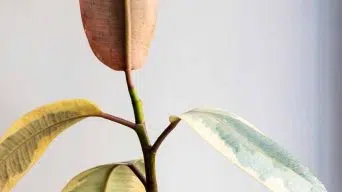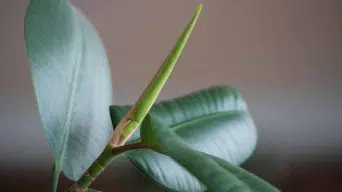Key Takeaways
- Rubber plants thrive in medium to bright indirect sunlight, making it essential to choose the right light conditions for them indoors. They require at least 6-8 hours of light per day.
- Proper watering and drainage are crucial to keeping your rubber plant healthy. Water when the soil feels dry, and use a pot with bottom drain holes to prevent root rot.
- Advanced care techniques like pruning, staking and support, propagation methods, and repotting can help perfect rubber plant care and create stunning focal points in any room. Remember that different types of soil may affect how often fertilization is needed.
Are you looking to add a touch of natural beauty and sophistication to your home?
Look no further than the rubber plant (Ficus elastica), a stunning low-maintenance tree that thrives indoors and outdoors.
This guide on how to grow rubber plants indoors will walk you through every step, including choosing the right light conditions, watering and drainage techniques, potting soil selection, pruning methods, and much more.
The Basics Of Growing A Rubber Plant (Ficus Elastica) Indoors
If you want to grow a rubber plant (Ficus Elastica) indoors and keep it healthy, consider a few key things.
Choose the right light conditions, water and drain properly, maintain appropriate temperature and humidity levels, fertilize regularly with nutrient-rich potting soil, pick a suitable container, and learn how to identify and treat common pests and diseases.
Choosing The Right Light Conditions
Selecting the ideal light conditions is crucial for your rubber plant (Ficus elastica) to thrive indoors.
Rubber plants flourish in medium to bright indirect sunlight, needing at least six to eight hours of light every day.
Although they can survive in lower light conditions, providing them with full direct sunlight all day long or bright indirect light will significantly enhance their growth and overall health.
It’s important to be aware of signs that your rubber plant may need more light exposure.
For instance, noticing droopy leaves on your indoor tree might indicate that it needs more sunlight.
Watering And Drainage
Caring for a rubber plant requires paying close attention to its watering and drainage needs.
Proper hydration is key for this tropical plant; overwatering can lead to rotting roots and other issues.
To ensure healthy growth, water your rubber plant when the soil feels slightly dry to the touch, usually about once a week during warmer months or every two weeks in winter.
Drainage is just as vital for maintaining the health of your indoor rubber plant.
Select a pot with bottom drain holes that allow excess moisture to escape instead of pooling around the roots.
Additionally, using a well-draining potting mix like cactus soil can prevent root rot by allowing air circulation between watering sessions.
Temperature And Humidity
Rubber plants thrive in moderate to warm temperatures, ideally ranging between 60°F and 75°F during the day and slightly cooler at night, between 60°F and 65°F.
Maintaining a consistent temperature within this range ensures optimal growth for your indoor rubber plant.
Apart from comfortable temperatures, rubber plants also appreciate a humid environment that mimics their tropical origins.
To maintain sufficient humidity around your houseplant, consider placing it on top of a tray filled with water and pebbles; as the water evaporates, it creates a humid microclimate for the plant while keeping its roots above standing water.
Alternatively, you can mist the foliage periodically using distilled water or invest in a dedicated air humidifier designed for indoor plants.
Fertilizing Needs
Rubber plants (Ficus Elastica) require regular fertilization to maintain their health and vitality, but like any plant, too much of a good thing can be detrimental.
Over-fertilizing can cause rubber plants to become leggy with long stems and few leaves.
To avoid this problem, it is recommended that you use a 3:1:2 fertilizer such as Dyna Gro Foliage Pro during the summer growing season. Homemade fertilizers such as fish emulsion or compost tea are also great options for maintaining healthy growth in rubber plants.
It’s important to remember that different soil types may affect how often your rubber plant needs fertilizing.
Orchid potting mix or succulent soil can work well for these indoor plants; however, cactus soil is not recommended.
Potting Soil And Container Selection
The right potting soil and container selection can help set your rubber plant up for success when growing indoors.
Miracle-Gro® Indoor Potting Mix is an excellent option for planting rubber plants, as it provides the necessary nutrients and drainage to allow the roots to thrive.
When selecting a container, choose one that allows room for growth and has adequate drainage holes to prevent water from accumulating in the bottom of the pot.
Remember to avoid pots that are too large, which could lead to overwatering or root rot.
Additionally, decorative containers without drainage must be paired with an inner pot with proper drainage holes to ensure healthy growth.
Identifying And Treating Common Pests And Diseases
Rubber plants are generally hardy and resistant to pests.
However, they can still be affected by several common sap-sucking insects such as mealybugs, spider mites, scale, and aphids.
You can identify these pests by looking for small dots on the leaves or stems of your rubber plant.
To treat these pests, first, isolate the infected plant in case other nearby plants have not yet been affected.
Using a damp cloth or sponge with soapy water effectively removes bugs from your plant’s foliage. Using organic insecticidal soap also helps control pest populations.
In addition to pests that cause damage directly, such as scaling and infesting leaves with holes, another threat is disease causing bacteria in soils.
Advanced Care Tips For Growing A Healthy Indoor Rubber Plant
Discover advanced care tips to help you grow a healthy indoor rubber plant.
These include pruning, staking and support techniques, propagation, and repotting.
Proper Pruning Techniques
Properly pruning your rubber plant is essential for its health and appearance.
Here are some tips for effective pruning:
- Start by removing any dead or yellowing leaves. These can become a breeding ground for pests or diseases.
- Cut back any leggy stems to encourage bushier growth. Aim to cut just above a leaf node, where new growth will emerge.
- If you want to shape your plant, remove the top portion of the stem. This will encourage branching and create a fuller appearance.
- Use sharp, clean pruning shears to avoid damaging the plant or spreading disease.
- Prune sparingly during the winter months when the plant is in its dormant stage.
Remember, every time you prune your rubber plant, it expends energy, creating new growth.
Be sure not to over-prune and stress out your plant too much.
Following these proper pruning techniques will help ensure your rubber plant thrives and looks great all year round!
Staking And Support
Ensuring your rubber plant grows appropriately and maintains its beautiful shape, staking, and support is crucial.
Here are some tips to help you provide the proper support for your indoor rubber plant:
- Stakes can be made from bamboo or wooden dowels inserted into the soil near the base of the rubber plant and tied to the stem with soft twine or string. This will help keep the plant upright as it grows taller.
- If your rubber plant has multiple stems, tying them together can help create a fuller, more cohesive appearance. Use soft twine or string to loosely tie stems together at several points along their length.
- As your rubber plant grows taller, you may need to add stakes and ties to provide enough support.
- Along with staking, pruning your rubber plant can also help encourage healthy growth patterns and prevent it from becoming too tall or top-heavy.
- Always avoid using harsh ties or materials that could damage the stems or leaves of your rubber plant.
Propagation Methods
One great thing about rubber plants is that they’re relatively easy to propagate.
Here are a few different methods you can try:
- Stem cuttings: Take a stem cutting with a few leaves and nodes and remove the bottom leaves so that only the top 2-3 leaves remain. Dip the end of the stem in rooting hormone (optional) and plant it in moist soil or put it in water until roots form.
- Air-layering: This method involves wounding the stem, wrapping it with damp sphagnum moss or coco coir, and covering it with plastic wrap until roots develop. Once roots have formed, you can cut off the rooted section of the stem and plant it in a pot.
- Division: If your rubber plant has multiple stems growing from one root ball, you can divide it by carefully separating the stems and repotting them in their pots.
Remember to keep your newly propagated rubber plants in a warm, humid environment while they establish themselves.
And don’t be afraid to experiment with different propagation methods to see what works best for you!
Repotting Strategies
Repotting your rubber plant is essential to maintain its health and vitality.
Here are some repotting strategies to keep in mind:
- Choose the right pot size: The new pot should be slightly larger than the current one, allowing room for growth.
- Provide proper drainage: Ensure the new pot has drainage holes to avoid waterlogging of roots, which can lead to root rot.
- Use fresh soil mix: Prepare a good quality potting mix that contains slow-releasing nutrients and provides excellent drainage.
- Remove the plant carefully: Gently remove the rubber plant from its existing container, ensuring not to damage its roots.
- Trim the roots: Inspect the roots for any signs of damage or disease and trim them if necessary before planting in fresh soil.
- Plant at a similar depth: Ensure that you plant at an equal depth as it was planted previously, leaving enough space at the top for watering.
- Water well: Once you have potted your rubber plant into its new home, water it thoroughly until excess water drains out of the bottom of the container.
Creative Ways To Decorate With Rubber Plants Indoors
Looking for ideas on how to decorate your indoor space with rubber plants?
Here are some creative tips: arrange them at varying heights and pair them with other plants to achieve a tropical vibe.
Alternatively, you can make a statement with a single rubber plant by placing it in a decorative pot.
Mix and match with succulents, peace lilies, or fiddle leaf figs to create a personalized and unique look that fits your style.
Creating Stunning Focal Points
Rubber plants can be a beautiful addition to any room and serve as stunning focal points.
Here are some creative ways you can decorate with rubber plants indoors:
- Use a large rubber plant as a statement piece in a room to draw attention to its unique leaves.
- Create a botanical gallery wall by hanging and arranging different sized rubber plants on the wall.
- Place several small rubber plants on a shelf or table for a cohesive look.
- Hang a macrame plant hanger from the ceiling with a trailing rubber plant for an ethereal effect.
- Mix and match your rubber plant with other houseplants for added texture and color.
Incorporating Rubber Plants Into Existing Décor
Rubber plants are versatile and can be integrated into many existing décor styles.
Here are some ideas for incorporating rubber plants into your home:
- Create stunning focal points: Place your rubber plant in a decorative pot or basket and use it to draw attention to a specific area of the room.
- Mix and match with other houseplants: Pair your rubber plant with other indoor plants that complement its green foliage, such as succulents, peace lilies, or fiddle leaf figs.
- Arrange plants in groups: Create an attractive display by placing rubber plants of varying sizes on a table or shelf.
- Use as room dividers: Large rubber plants can create natural partitions in larger rooms, adding interest and providing privacy.
- Blend with existing décor: Incorporate rubber plants into your existing décor by choosing pots or baskets that match your style or color scheme.
Arranging Plants In Groups
One creative way to decorate your plants is by arranging them in groups.
Here are some tips on how to do it:
- Choose various rubber plant types and sizes to create visual interest and contrast.
- Group plants with similar light and watering need together to make caring for them more manageable.
- Experiment with different container styles, such as hanging baskets or decorative pots, to add depth and dimension to your display.
- Consider incorporating other houseplants or decorative items, like stones or driftwood, to enhance the visual appeal of your arrangement further.
- Use room dividers or shelves to create a dedicated space for your group of rubber plants, adding a touch of natural beauty to any room in your home.
Mixing And Matching With Other Houseplants
Pairing your rubber plant with other indoor plants is a great way to create a beautiful green space in your home.
Here are some ideas for mixing and matching with other houseplants:
- Pothos – The trailing vines of pothos perfectly complement the upright growth of a rubber plant.
- Succulents – Pairing rubber plants with succulents creates an exciting contrast in texture and form.
- ZZ Plants – These low-maintenance plants thrive in the same conditions as rubber plants, making them an excellent match.
- Peace Lily – A peace lily’s dark green leaves contrast the bright green foliage of a rubber plant.
- Fiddle Leaf Fig – Both fiddle leaf figs and rubber plants have large, glossy leaves that look stunning together.
- Snake Plant – The tall, upright growth of snake plants makes them an excellent companion for rubber plants’ more sprawling growth habit.
- Spider Plant – The arching foliage of spider plants adds another dimension to the shape and texture of a grouping that includes rubber plants.
- English Ivy – The trailing ivy vines can be trained to grow around taller houseplants like rubber trees, adding visual interest and dimensionality.
Final Thoughts
With the proper care and attention, your rubber plant can thrive and add a lovely touch of greenery to any room.
Remember to keep in mind the basics, such as proper watering and lighting, as well as advanced techniques, such as pruning and propagation, for optimal growth.
With these tips at your fingertips, there’s no limit to the beauty you can create with your indoor rubber plant.







